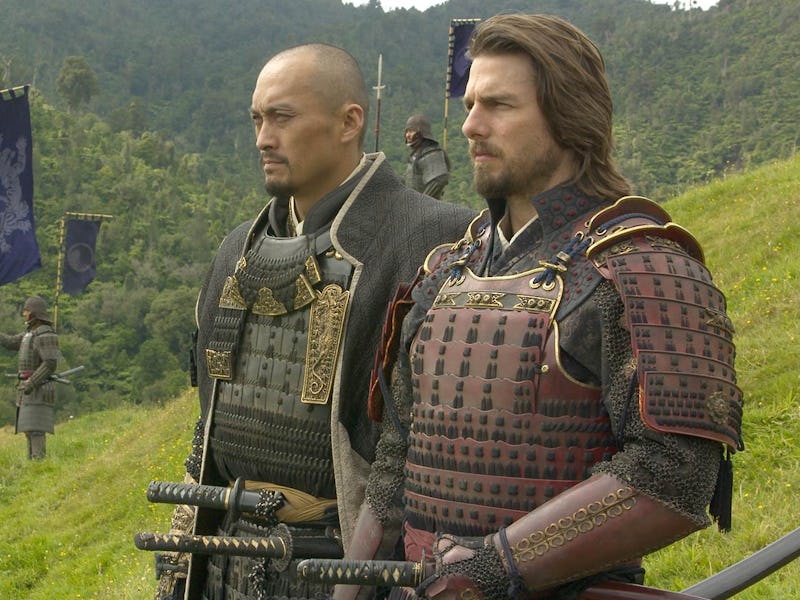Tom Cruise’s Historical War Epic Remains Controversial — and Underrated
The Last Samurai may be a product of its time, but it was also a step forward for representation.

Discussions of The Last Samurai often focus on the obvious incongruity of a movie where Tom Cruise dons samurai armor to become the steward of traditional Japanese culture. The picture of Cruise’s bearded, American-Jesus-like face, writ large on a movie poster under the word “samurai,” was more a symbol of Hollywood tradition when the film appeared in theaters on December 5, 2003. Yes, this is a white-savior narrative — Cruise’s cosplaying can’t disguise it — but the first face onscreen is Ken Watanabe, who received an Oscar nomination for his role as Katsumoto, the samurai leader. What the actors represent offscreen, culturally, is the reciprocal of their characters and the film’s central conflict between tradition and modernization.
The Last Samurai follows Cruise’s character, Captain Nathan Algren, a guilt-ridden, mercenary veteran of the American Indian Wars who enters Japan to train the Emperor’s army so they can quell a samurai revolt. Set early in the Meiji era, when Japan opened to the West after 200-plus years of isolationism, the film pits Katsumoto and the country’s old, sword-wielding, feudal ways against new American technologies like the Winchester rifle and the dreaded howitzer. That these are weapons is almost incidental to the plot; the old and new are vying for dominion.
In the opening scene, Katsumoto realizes something’s amiss when his idyllic mountain meditation is interrupted by a vision of a white tiger. This is a premonition of Algren, who inhabits a more industrial milieu when we meet him at a San Francisco trade show. There, “railroads, cannons, and Western clothing,” as Emperor Meiji (Shichinosuke Nakamura) later puts it, are ready to be exported to Japan. Trotted onstage with brass fanfare as a sham war hero, Algren raises his rifle in a drunken stupor and tells the audience, “My thanks on behalf of those who died in the name of better mechanical amusements and commercial opportunities.”
These words, a eulogy for the innocent Cheyenne village he helped massacre, could apply equally to Katsumoto’s samurai generation as it rides in through the mists of time, clashing with contemporary, mechanized forces on the battlefield in Japan. Even before that, Timothy Spall’s British narrator notes how “the ancient and the modern are at war” for the country’s soul.
In telling the story of Japan’s Westernization (really, its Americanization, transposed from post-World War II in a turn-of-the-millennium historical epic), director Edward Zwick relies on cinematic convention. He even repeats a scene from his own Civil War movie, Glory, where the commanding officer in dark blue deliberately rattles the non-white soldier-in-training to prove he’s not ready to hit a target under pressure. At the same time, the Japanese actors who surround Cruise in prominent roles show they’re more than capable of holding their own against the international movie star.
Cruise may be the headliner, but Watanabe is the movie’s soul.
Hiroyuki Sanada plays Katusmoto’s second-in-command, Ujio, and like Watanabe, he’s another actor who’s remained in the limelight (though perhaps not enough so) 20 years after The Last Samurai. By introducing global audiences to such talents, the film arguably did more to move the needle, representation-wise, than other 2003 releases like Lost in Translation and Kill Bill, Vol. 1 (both set in Japan, but with fewer top-billed Japanese names).
In this way, The Last Samurai managed to plant one foot in the future despite being stuck in the Eurocentric past, with Zwick and co-screenwriters John Logan and Marshall Herskovitz framing the narrative. Even Algren’s love interest, Taka (the mononymous Koyuki, fresh off Kiyoshi Kurosawa’s Pulse), isn’t thrilled about playing house with the unwashed foreigner who killed her husband.
In the third act, Cruise predictably wears his plot armor as the movie goes full Braveheart (with the same cinematographer, John Toll). These internal tensions somewhat reflect the story’s underlying concern with the double-edged sword of progress. If nothing else, The Last Samurai was, as Watanabe alluded in The Guardian last year, a crossroads away from the kind of offensive yellowface caricatures seen in Breakfast at Tiffany’s.
“Before The Last Samurai,” Watanabe said, “there was this stereotype of Asian people with glasses, bucked teeth and a camera. It was stupid, but after [The Last Samurai] came out, Hollywood tried to be more authentic when it came to Asian stories.”
While not above reproach, The Last Samurai was a landmark in more authentic Hollywood representation.
The film is loosely based on real Japanese history, with Katsumoto standing in for Saigo Takamori (1828–1877), who led the Satsuma Rebellion and has been called the “last true samurai.” Starting the action in 1876 aligns it with America’s centennial as it reconfigures around Algren, who’s only out for capitalist gain until he sees the beauty of the cultural paradigm he’s worked to obliterate. That’s what The Last Samurai is really about, but it’s easy to lose sight of its broader theme when the movie is so very specific about the story it’s telling (and who’s telling it).
Katsumoto mourns the loss of traditions, something Cruise and other real-life proponents of the theatrical experience might find relatable now more than ever. These days, The Last Samurai’s widescreen visuals are relegated to your typical streaming service, Paramount+. Before it landed there, the film’s supporting cast helped prime the Academy Awards for homegrown Asian films like Parasite and Japan’s own Drive My Car. Nothing can stop progress.